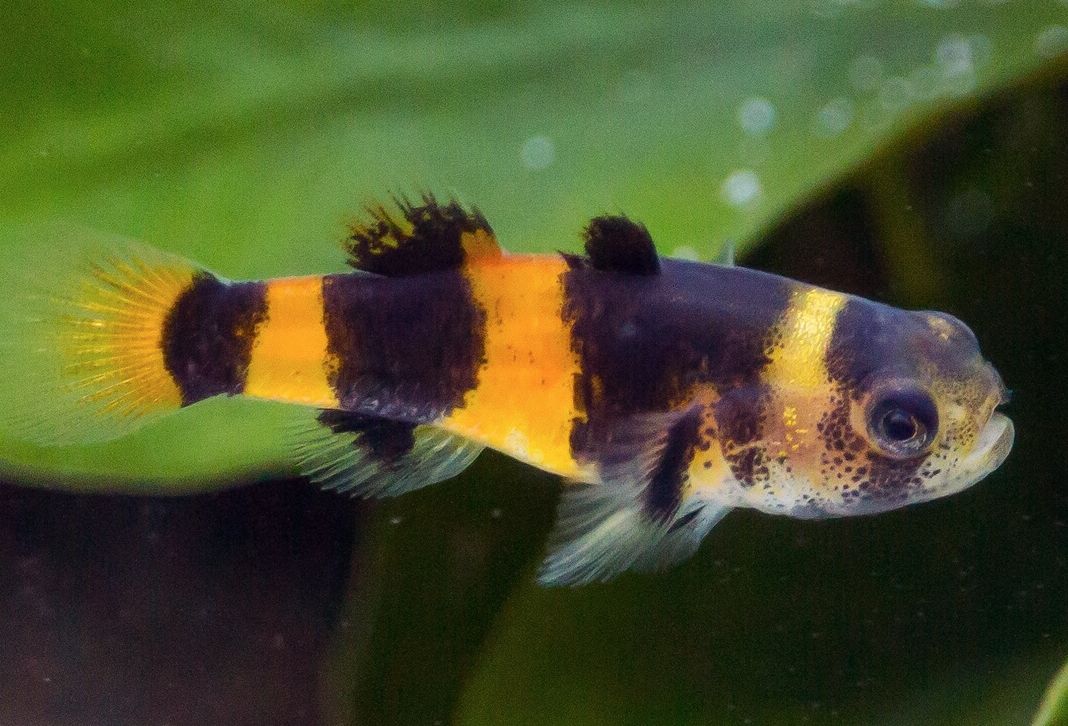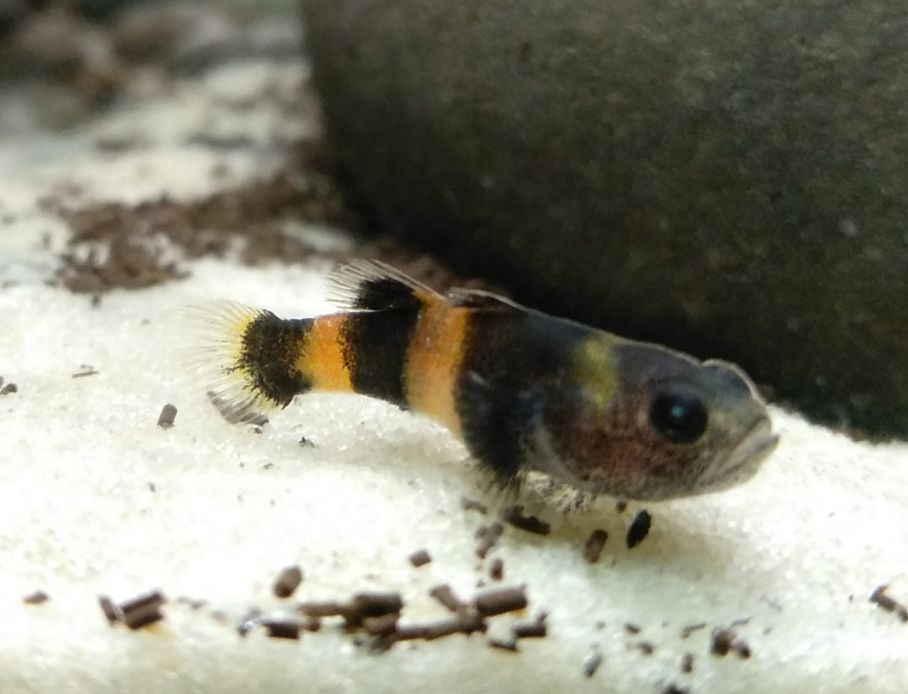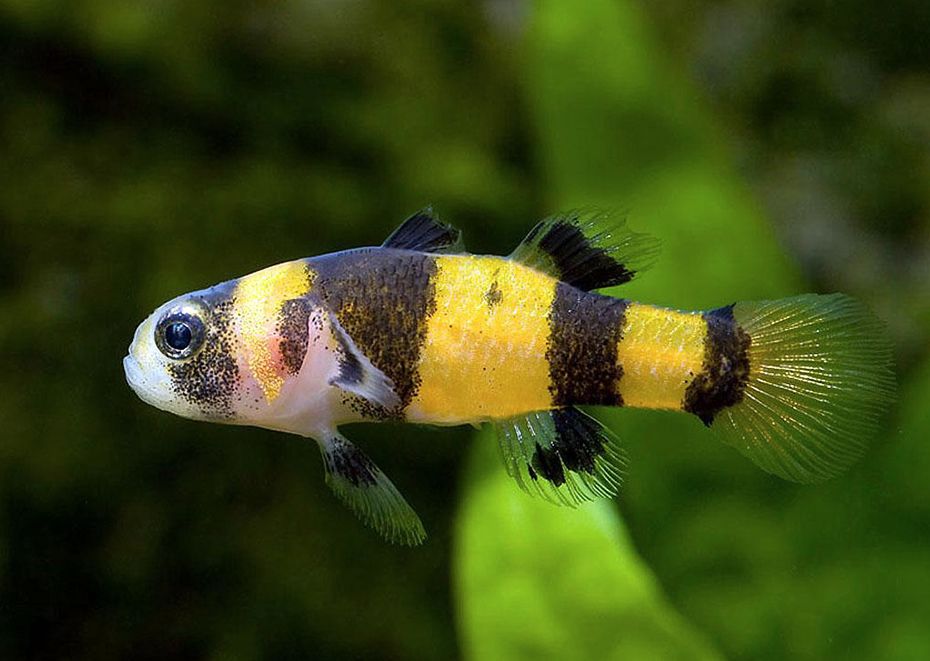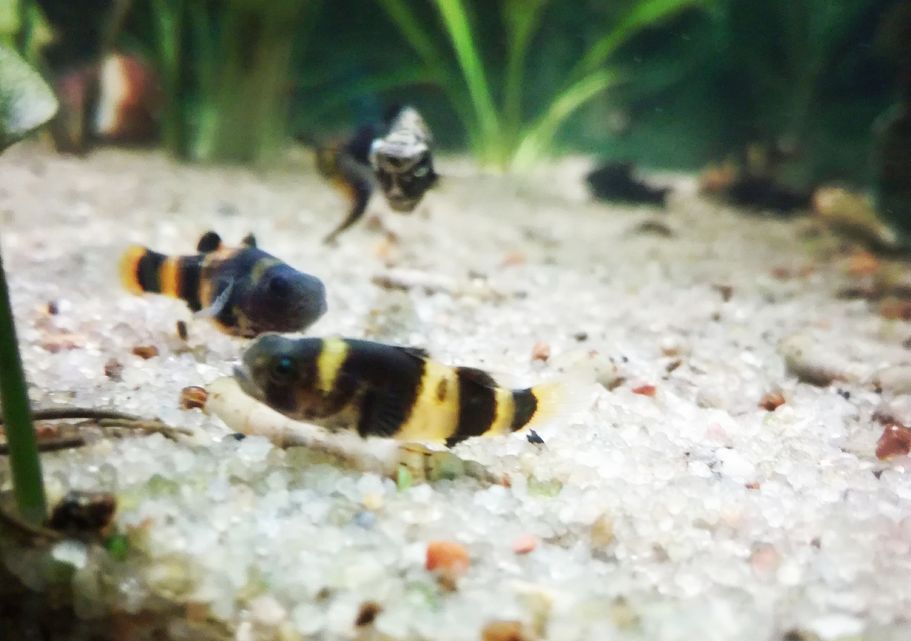The bumblebee goby (Brachygobius doriae) is a small, bright and peaceful fish which nano tank owners eagerly buy. Further in the article, you’ll find out how to keep bumblebee goby, feed it, select tank mates, and breed it.

Contents
Habitat in the wild
The bumblebee goby is native to Southeast Asia, specifically found in brackish and freshwater habitats of rivers and coastal areas in countries like Thailand, Malaysia, and Indonesia. It dwells in lowlands with brackish water along coastline – such as mangrove swamps, estuaries of rivers running into the sea.
As a rule bottom there consists of clay loam, sand and mud with some organics on it, such as fallen leaves, mango tree roots and snags. Some populations of the bumblebee fish dwell in old peatbogs with black water that has very low acidity level, minimal conductivity and insignificant hardness level.
| Characteristic | Description |
|---|---|
| Common Name | Bumblebee goby, bumblebee fish, bee fish |
| Scientific Name | Brachygobius doriae |
| Family | Oxudercidae |
| Size | Up to 4-5 centimeters (1.5-2 inches) in length |
| Body Shape | Cylindrical with a large head and compressed tail |
| Coloration | Primarily black with vibrant yellow or white stripes |
| Native Habitat | Southeast Asia (Thailand, Malaysia, Indonesia) |
| Habitat | Shallow, slow-moving waters, brackish and freshwater habitats |
| Behavior | Bottom-dwelling, territorial, perching locomotion |
| Tank Size | Minimum of 10 gallons for a small group |
| Water Parameters | Slightly brackish or freshwater, stable conditions |
| Substrate | Sandy substrate preferred for burrowing behavior |
| Diet | Carnivorous, feeds on small invertebrates and insect larvae |
| Compatibility | Peaceful, small fish or species-only setup |
| Breeding | Nest-builders, males guard and care for eggs |

Description
Body
The bumblebee goby body shape is the one peculiar to all representatives of its kind – it looks like an elongated drop flattened from sides. The head is large if compared to its body size. Its fused abdominal fins form kind of sucker disk by means of which the fish sticks to various surfaces. There are front and back soft rays on two dorsal fins.
Color
Provided with favorable tank conditions the fish has very bright and contrast coloring pattern of golden-yellow and tar dark stripes that go in turns, which makes the fish look like a bee and due to this bumblebee goby got its name. Some species have blurry dark spot on their back.
Size
How big do bumblebee gobies get?
The bumblebee goby is a small fish species. On average, they reach a maximum size of about 5 centimeters (2 inches) in length. But in a tank the bumblebee fish grows a bit smaller, up to 4.2 centimeters (1.7 in) long.
Lifrspan
On average, bumblebee gobies have a lifespan of about 2 to 4 years in captivity. However, with proper care and optimal conditions, some individuals have been known to live up to 5 years or even slightly longer. Factors that can influence their lifespan include water quality, diet, tank size, compatibility with tankmates, and overall health maintenance.

Difficulties in keeping
This is a small, bright, but rather demanding fish. Besides this is a small predatory fish that will eat everything it can swallow. Therefore, the bumblebee fish isn’t recommended for beginner aquarists.
Keeping in a tank
Tank size
The recommended minimum tank size is approximately 38 liters (10 gallons) for a small group of bumblebee gobies. Optimal tank size for a small group of fish starts with 80 liters (20 gallons). Also you should remember that goby is a territory dependent fish. To avoid conflicts and fights in the tank you should keep a group of at least 6 species, which decreases the level of their aggression plus the bumblebee fish becomes less timid and demonstrates more natural behavior. It’s better to choose not very deep tank with large base area.
Tank decor
Lots of shelters made of thickly planted tank plants is a must to make sure that weaker fish species don’t suffer from attacks of alpha male. Snags, artificial caves and flower pots will also do for this purpose.
Sand will be a good choice for the tank bottom substrate. You may add coral sand or marble gravels into the sand on the tank bottom to act as a buffer and put some sea salt into the tank water – about 2 grams per one liter of water. This isn’t obligatory, though it is useful in terms of disease prevention.
It’s not necessary to put plants into the tank, but if you want you can use some undemanding kinds, but before this they have to get acclimatized to living in brackish water.
Filtration
Successful keeping of the bumblebee goby depends on maintaining stable hydrochemical water composition and high water quality. For this purpose powerful filtration system is used and regular servicing procedures are performed: daily tank water renew and removing of organic waste from the tank.
Water parameters
You have to keep in mind that bumblebee goby is a fish that dwells in brackish water and sometimes it is put into freshwater tanks. Some aquarists successfully keep it in freshwater, but still ideal tank conditions for the fish is living in brackish water.
When choosing the filter you should opt for the models that don’t create any excessive water flow. Tank water parameters should be the following: temperature 24 – 28 °C (75 – 82 °F), pH: 7.0 – 8.5.
Diet
The bumblebee goby is a micropredator. It is a carnivorous fish, that’s why it’s preferable to feed it with small live and frozen food. This can be tubifex, bloodworms, brine shrimp and daphnia. The fish gathers its food from the tank bottom.
Usually it refuses to eat artificial food. The bumblebee fish is quite demanding in terms of feeding and may not eat during the first several days after you put it into a new tank. You should feed fish often with small portions of food.

Tank mates
Keeping a small group of bumblebee gobies together can be a good option. They are social fish and usually tolerate their own species well. However, keep an eye on any signs of aggression or territorial behavior, especially among males. It’s generally recommended to keep bumblebee gobies in a small group of at least 6 individuals. Keeping them in groups helps create a more natural social dynamic and reduces stress.
Bumblebee goby is not suitable for community tanks, since it requires brackish water and it is a territory dependent fish.
The males fight for their territory on the tank bottom and despite this it is recommend to keep not less than 6 species in a school to make sure that they don’t demonstrate aggression towards other tank dwellers. This is why there should be enough of shelters in the tank.
The bumblebee goby is compatible with other calm tempered species of equitable size and capable of living in brackish water. Fishes that swim in the middle water layers or near the surface are more preferable as tank mates.
Micropredators eagerly feed on shrimps, therefore it’s better not to keep them with cherry shrimp and other small shrimps.
Gender differences: male vs female
Females are larger and fatter, before spawning their abdomen becomes rounded. Males are noticeably thinner and often they have brighter coloring (their stripes are orange, not yellow) and during the spawning process their coloring becomes even brighter (these stripes get almost red).

Breeding
The bumblebee goby can spawn both in a species and in a spawning tank. Bumblebee goby spawns in small caves which you can make from flower pots, empty tubes, shells.
It is better to get 6-10 species and give them a chance to form couples themselves in a natural way. Before spawning the bumblebee fish should have high and diversified diet. Spawning is triggered with tank water renew, rising water temperature at several degrees and intensive aeration.
The spawning itself occurs in a shelter. The male chooses a proper place and waits till the female passes by. When the female is ready, she swims into the cave and lays 100-200 eggs and leaves them after that. The male fertilizes the eggs and stays to protect the offspring.
Females don’t take any part in growing the juveniles and you can remove them from the tank at this stage.
As for the males, they stay in the shelter and guard the eggs till the larvae hatches. Egg stage lasts for 7-9 days. The juveniles start to swim several days later.
First the bumblebee goby juveniles feed on their yolk beg leftovers and then you should start feeding them with infusorians and rotifers. Even a short period of starvation may lead to mass mortality of the offspring.
When the juveniles grow a bit, they can eat chopped tubifex and brine shrimp nauplii.
The juveniles grow very slowly and they become 1 cm long only at the age of 1 month provided with high feeding. At the age of 2 month the bumblebee fish starts to demonstrate coloring and behavior peculiar to the adult species. The fish becomes reproductive at the age of 8-12 month.